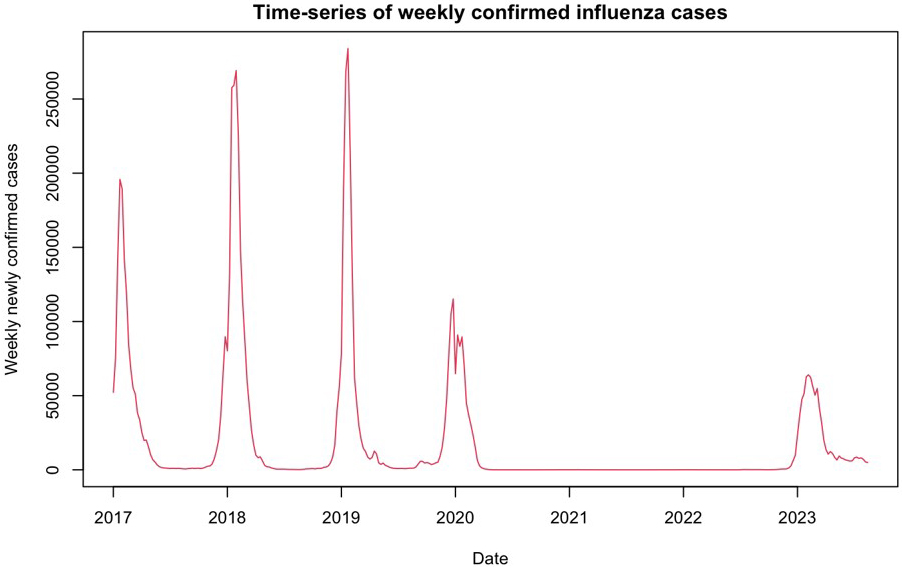Corresponding author: Keita Wagatsuma, waga@med.niigata-u.ac.jp
DOI: 10.31662/jmaj.2023-0150
Received: September 20, 2023
Accepted: September 27, 2023
Advance Publication: November 16, 2023
Published: January 15, 2024
Cite this article as:
Wagatsuma K, Otoguro T. Changing Seasonality of Influenza in the Post-COVID Era in Japan. JMA J. 2024;7(1):138-139.
Key words: Seasonality, Influenza, COVID-19, Epidemics, Japan
To the Editor: The onset of the coronavirus disease (COVID-19) pandemic has transformed our policies and behaviors, even our economy and education, and continues to have a threatening impact on people’s health even today (1). In this context, it is necessary to emphasize that the dynamics of seasonal influenza, which is more common and burdensome in Japan, have also been considerably affected.
With Japan’s abandonment of pandemic control measures, the resurgence of seasonal influenza as a major public health concern now appears inevitable. As a practical matter, notifications of influenza across Japan have surged considerably earlier than usual, reaching a record high at the time of writing, after three years of relative silence (Figure 1). This surge has prompted school closures in multiple prefectures, notably with 22,111 cases reported during the week of September 15, 2023, a staggering 166-fold increase compared to the 133 cases reported in the same period a year earlier (2). This surge has led to the closure of 10 school buildings and the suspension of classes in 627 schools nationwide. Notably, more than 90.0% of these cases were attributed to influenza A/H3N2, a strain known to cause severe epidemics.

The resurgence of seasonal influenza epidemics following a pandemic has also been observed in other regions, such as the United States and Australia, highlighting that Japan’s experience is not unique (3). The sharp increase in cases can be attributed to the relaxation of measures due to the pandemic and the decrease in the opportunity to acquire antibodies via natural infection; consequently, the level of population immunity against the currently prevalent virus is likely significantly lower than before (4). This situation may be exacerbated by children under five years of age who have never been exposed to influenza and by individuals at a high risk of severe illness, including older adults and pregnant women. The occurrence of new outbreaks may further strain healthcare resources and lead to delays in diagnosis.
Herein, we report a substantial outbreak of seasonal influenza in Japan that began in the summer of 2023. In Japan, this season’s vaccine supply is adequate, with approximately 16.6 million doses expected to be available as of September 2023; therefore, early vaccination is recommended due to potential early and larger outbreaks (5). These observations offer valuable insights into the repercussions of COVID-19-related disruptions and highlight the importance of concerted efforts to unravel the knowledge gaps that remain despite years of research.
None
Both authors conceptualized the manuscript. KW wrote the original draft and TO critically edited it. Both authors read and approved the final version of the manuscript.
Not applicable.
Tsubaki M, Kako J, Koga Y, et al. Are there changes in the nursing managers’ expectations of the professional quality of new graduate nurses after the emerging of infectious disease pandemic? JMA J. 2023;6(4):532-5.
Ministry of Health, Labour and Welfare, Japan. Influenza [Internet]. 2023 Sep [cited 2023 Sep 17]. Available from: https://www.mhlw.go.jp/stf/seisakunitsuite/bunya/kenkou_iryou/kenkou/kekkaku-kansenshou/infulenza/index.html
Nazareth J, Pan D, Martin CA, et al. Is the UK prepared for seasonal influenza in 2022-23 and beyond? Lancet Infect Dis. 2022;22(9):1280-1.
Taniguchi Y, Kuno T, Komiyama J, et al. Comparison of patient characteristics and in-hospital mortality between patients with COVID-19 in 2020 and those with influenza in 2017-2020: a multicenter, retrospective cohort study in Japan. Lancet Reg Health West Pac. 2022;20:100365.
Ministry of Health, Labour and Welfare, Japan. Seasonal influenza vaccine [Internet]. 2023 Sep [cited 2023 Sep 17]. Available from: https://www.mhlw.go.jp/content/10906000/001146456.pdf